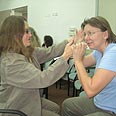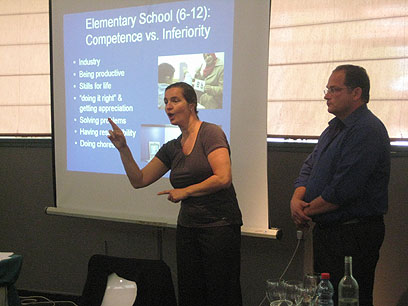
1st conference for deaf-blind persons in Israel a 'momentous event'
Beth David Institute’s Center for Deaf-Blind Persons hosts 'Building Bridges' conference. Internationally renowned deaf-blind activist: Have hope; not for a cure, but for a good life
The two-day "Building Bridges" conference took place May 9-10 in Tel Aviv. Jelica (pronounced Yelitza) Nuccio was the first distinguished deaf-blind person to visit Israel since Helen Keller in 1952. As the project director of the National Support Service Provider Pilot Project and political activist, Nuccio came to Israel to share her experience as a fully independent member of the deaf-blind community.
An estimated 1,200 deaf-blind people live in Israel, and The Beth David Institute’s Center for Deaf-Blind Persons hopes to help them to lead full and independent lives.
The most common cause of deaf-blindness today is Usher Syndrome, a genetic eye disorder formally called retinitis pigmentosa. Deafness is the first symptom of the disorder followed by progressive vision loss. The disorder, generally onset during youth, creates a dramatic life change for the individual. Although there is no cure yet for Usher, Nuccio and fellow guest Theresa Smith emphasized that it is important for one to "Have hope; not for a cure, but for a good life."
Nuccio presented a workshop on how to support children and young adults with Usher Syndrome (I, II, and III). She also shared her personal experiences of a lifetime with the disorder, and spoke about technological advancements in public transportation brought about by government legislation in the United States.

'Make life more accessible.' Conference (Photo: Josh Simon)
The Americans with Disabilities Act requires any public company, office or system to be accessible to disabled persons in the US. For example, in some train stations, text messages are sent to the deaf-blind person's cell phone that features a 'refreshable Braille' display to notify them which train is coming. Other advancements include vibro-tactile devices at crosswalks that indicate to deaf-blind people when the light is green or red, as well as signs they can hold to notify bus drivers that they are deaf-blind and which bus number they are waiting for. She then suggested future innovations that would be beneficiary on a personal level, such as signaling doorbells, fire alarms, welcome mats that send a vibrating signal to the deaf-blind person when he or she steps on it, etc.
Although Israel has resources for deaf-blind people to communicate and use computers, they are far behind the American efforts to make the public transportation more easily accessible to members of the deaf-blind community.
So what does the Beth David Institute expect to come out of this conference? "It is our hope and expectation that this conference will put the subject of deaf-blindness on the national agenda for policymakers and encourage them to make life more accessible both physically and emotionally for deaf-blind and other disabled communities" said Institute representative Josh Simon.
The co-sponsors of the conference were The Perkins School for the Blind and Keren Or: The Jerusalem Center for Multi-handicapped Blind Children.
For more information visit the Beth David Institute's website at www.cdb.org.il.










